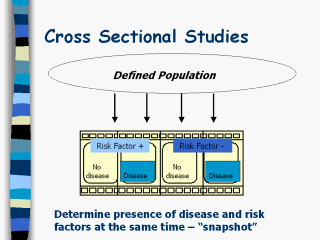| front |1 |2 |3 |4 |5 |6 |7 |8 |9 |10 |11 |12 |13 |14 |15 |16 |17 |18 |19 |20 |21 |22 |23 |24 |25 |26 |27 |28 |29 |30 |review |
 |
Another commonly used design used in
epidemiology is a cross sectional study. With this design, assessments of
disease and risk factors are performed at the same time. This gives you a
‘snapshot’ of the prevalence of disease and potential risk factors in a
community at a particular time. Example: Individuals who were diagnosed with type 1 diabetes between 2000 and 2007 were recruited from a large outpatient clinic. The were examined to determine if they had diabetes retinopathy (DR) and had ever smoked cigarettes. The prevalence of DR in this population was 40%. The prevalence of smoking among those with and without DR was 10% and 12%, respectively. Therefore, in this population, smoking did not appear to be a risk factor for DR. |